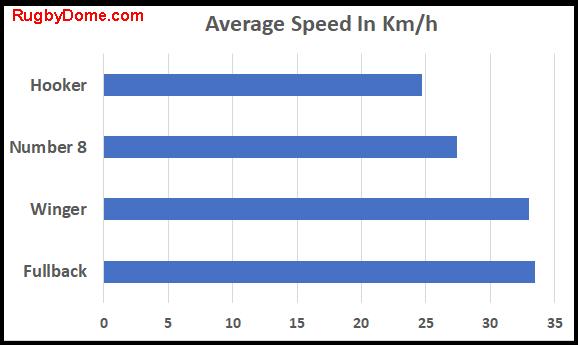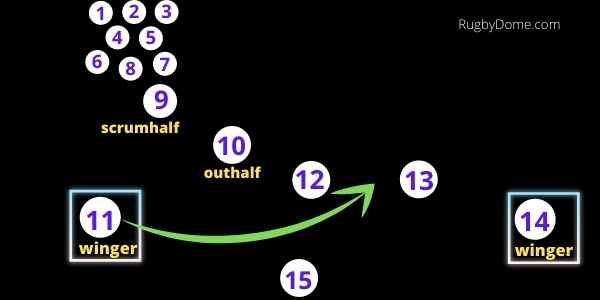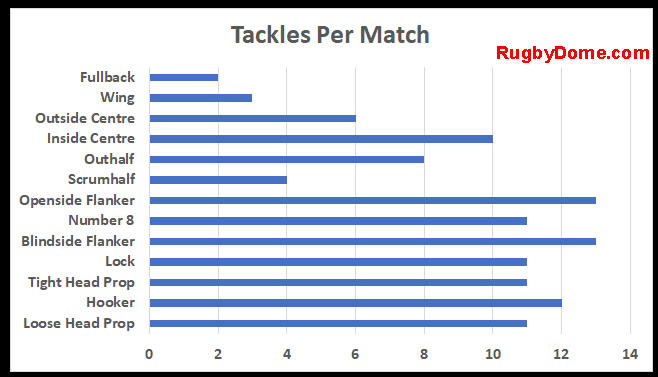There are two wingers in the starting fifteen players on a rugby team. They wear the number 11 and number 14 jerseys.
The positions are often known as the left and right wingers.
Wingers In Rugby Union
We have separate articles on wingers in sevens rugby and wingers in rugby league.
This article is about the 15-player sport of rugby union.
Like many fans, I switch between “wingers” and “wings” when I’m talking about the position.
What are wingers in rugby?
The two wingers in a starting rugby team are usually positioned closest to the left and right touchlines.
In attack, their teammates try to tie up defenders in midfield to pass to wingers out wide for attacking opportunities.
The diagram below shows where the two wingers are typically positioned at the start of a scrum.

The left winger, wearing number eleven, is the back nearest to the left side of the pitch.
The right winger, wearing number fourteen, is the player furthest from the start of the action near the right touchline.
You will see other configurations, particularly for the winger who is nearest the scrum.
When the scrum packs down close to a touchline, the nearest winger may move infield and stand behind the outhalf or the centres.
This is to keep the opposition flanker and scrumhalf guessing. The closer to the touchline, the easier it will be to defend the blindside and stop a break from the winger through a narrow gap.
When the winger moves infield, there are more moves and passing options in a big space.
What Do Wingers Do In Attack?
The wingers are key to finishing wide attacking moves that give them space to race with the ball down the touchline.
Wingers are usually amongst the fastest players on the pitch.
This chart shows measurements taken at the 2019 Rugby World Cup. As you can see, the only faster position was at fullback.

For a more detailed breakdown of speed, check out our article on how fast rugby players can get.
I’ll make the point here that wingers who elude their opposite number may be too fast for defenders who have to turn and race back to try to catch them.
That’s why the job of the fullback is to race across the field to make a cover tackle!
Finishers
Some elite wingers are known for waiting patiently out wide, pouncing on the few opportunities that come their way.
They hone their skills to be particularly evasive near the try line. A winger who can sidestep or simply outpace the last defender is worth their weight in gold.
The coach wants them to stay out wide for those few opportunities.
These wingers are often known as finishers.
Passing and continuity
Elite teams rarely have the luxury of two wingers that stay out on the try line during every attacking phase.
Instead, they deploy one winger who is comfortable with joining the play infield to act as another centre in open play. (You can read more in our article on the role of centres in rugby).
They pop up to take and give accurate passes and may initiate the play by taking the first pass from a ruck.
Here’s an example of an arcing run between the centres:

Joining the attack line
Wingers also love to arc in a line behind their attacking teammates, almost hiding from the defence.
Then they pick their moments to race forward to take a short pass through a gap created by having an extra player in the attacking line.
Ball carriers
Some of the best wingers in history have been small in stature.
Currently, Springbok Cheslin Kolbe is the first example that comes to mind.
When coaches have a smaller gem in their team, they often like to put a hard-running ball carrier on the other wing.
By this, I mean a bigger and stronger player who can carry the ball hard into contact and draw in several defenders in the tackle.
These big wingers can also barge through defenders close to the try line and use their strength to power over.
However, bigger players tend to be slower than the fastest elite wingers.
Jonah Lomu was a revelation because he was a big man who clocked amazing speeds. But a Jonah Lomu is a once-in-a-generation type of player.
What Do Wingers Do In Defence?
This graph shows the number of tackles made at each position in the 2021 Six Nations.

As you can see, wingers only make fewer tackles than fullbacks. We’ve got the raw numbers in our article on tackle rates per position.
I’ll say here that each wing made an average of three tackles in a match. For perspective, an inside centre makes ten.
This low number is one of the reasons that players new to the sport are often put on the wing. It’s perceived to be one of the easier positions to start with in rugby.
Wingers are still important in defence
Despite the low number of tackles, wingers play a vital role in defence.
They must work together and with the fullback to cover the large space behind their teammates in the backline.
If a winger is pulled out of position, the opposition outhalf will delight in kicking tactically into space into the corners of the pitch. This can lead to big territorial wins.
And those tackles may be the crucial try-saving tackles that win a game. A winger will race across the field to cover a break that gets past their teammate on the opposite wing.
There’s nothing that brings a bigger roar from the crowd than a last-ditch tackle in the corner that pushes the attacker into touch.
Other Positions
Our general overview of rugby positions and numbers has links to in-depth articles for each playing position.
Frequently Asked Questions
Here are quick answers to common questions.
What number is the left winger?
The left winger wears the number 11 jersey.
What number is the right winger?
The right winger wears number 14 jersey.
How many wingers are on a rugby team?
There are two wingers in the starting team in rugby.
Coaches often pick a player on the bench who usually plays on the wing or as a fullback. This player can substitute for any of the back three players (11, 14, and 15).
Other coaches take advantage of having a starting or bench centre who has experience playing on the wing. This means that one substitute back player can cover positions from 12 to 15.
That allows the coach to have more forwards on the bench for a tough forward-oriented match.